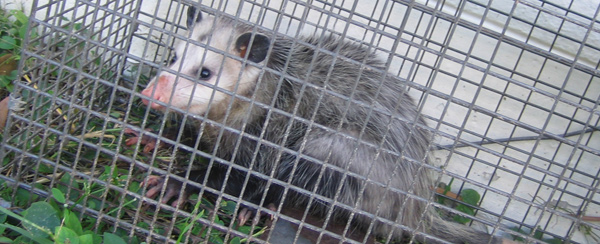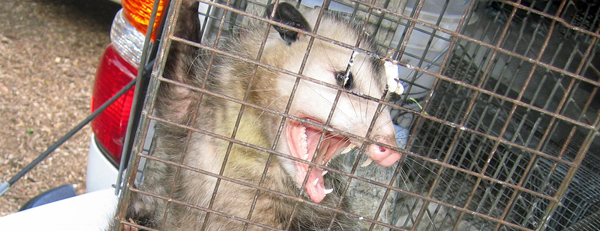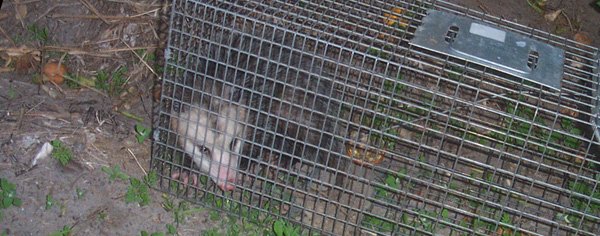- info@wildlife-removal.com
Call us for help in your town
Wildlife Removal Education
Possum Trapping - Trap Opossum
Need possum removal in your hometown? We service over 500 USA locations! Click here to hire us in your town and check prices - updated for year 2020.
If you have a problem with opossums on your property or living in your house, merely setting traps to catch and remove them will not necessarily solve your problem. In the case
of possums living in your house, attic, or walls, trapping alone probably won't cut it. However, you're at this page to learn how to trap opossums, so I'll give you the
information that I know.
Step 1: Make sure you understand the situation first - is it a mother opossum with babies in the spring or summer? How many animals are there? Have you properly identified the culprit as a possum?
Step 2: Buy a large steel cage trap, at least 32x10x12. Several manufacturers make traps of at least this size. Before you buy a trap, make sure it's legal for you to trap wildlife in your state.
Step 3: Set the trap in the right location - on flat ground, and make sure the trap doesn't wobble. Set it in a shady spot, so that the animal, once it's trapped, doesn't suffer in the hot sun. Set
it in a place the opossum frequently goes.
Step 4: Bait the trap - what is the best bait to catch possums? Opossums are omnivores, they scavenge, and they are not picky. However, they really seem to prefer smelly meat-based bait, so that'll work best. However, be aware that you
might catch a stray or your neighbor's pet cat, in which case you might want to use bread or marshmallows for bait.
Step 5: Check the trap frequently - you don't want the animal suffering in there for a long time.

Possum trapping
When you've trapped it and it's time to relocate the animal, be careful handling the trap. Don't stick your fingers inside the cage. The animal will probably poop in your truck bed or
car trunk, so put down a tarp or newspaper first. When you open the cage door to let the possum go, it'll probably just sit there. Blow on it to encourage it to run out of the cage.
Even though I wrote this guide, I've gotta be honest, simply setting a trap will rarely solve your opossum issue. If you have trouble, you may want to hire a wildlife specialist from
my list, who has seen a wide variety of opossum situations. And finally, please be humane to these animals. I think opossums are good animals. They have nice
temperaments. Don't
drown one or cause it to suffer, please.
You may want to read some of my other opossum articles:
possum removal -
opossums in the attic -
photos of possum poop -
types of possum problems -
possum trapping -
how to catch a possum -
pest control of possums -
possum in the wall -
possum in the house -
possum in basement -
possum repellent -
types of possum damage -
what is the opossum's diet? -
what is habitat of the opossum? -
what to do if you find an orphaned baby opossum -
should you remove opossums yourself or hire a professional? -
is trapping an opossum legal?.
I have discovered that May is a tricky month for Opossums trapping. This is because the young are starting to drop and move on their own, yet they tend to stick with the mother
for a few weeks. When I trap a mother opossum earlier in the spring, I often catch all of the nursing young along with her. In summer and autumn I catch only single opossums,
whether adults or first-years. However, in the month of May I must deal with the situation in a special manner. I must prepare to capture the young, up to ten of them, separately
from the mother. I learned this the hard way. I would catch a mother, and then deal with an angry customer claiming that the young were running amok. Or sometimes, I'd set a
large trap for the adult, and end up catching just one baby or more often, having my bait stolen by the young. I quickly learned to set a large trap with difficult to steal bait
(such as a lure scent that permeates into the ground) and higher pan tension. I then several, up to ten, small cage traps for the young. I would usually find that I'd caught the
mother and each of the babies, who hung around her and entered the small traps for food. Any small cage trap meant for squirrel or even chipmunk sized animals is fine. I personally
prefer the Havahart 0745. The solid metal top keeps spring rain from washing bait away. Setting extra traps for the young may seem tedious, but it is necessary - and you can charge
for it. Set your prices as you like, but I usually charge about a third of the cost of an adult for baby captures. You'll easily pick up all the young, so there is definitely money
to be made.
Opossum Situation: Sorry for the previous blank email. I've read enough of your site, found by accident while looking up "nose of black, get back Jack" you could add that to your coral snake page sayings...So I appreciate that there are things that you appreciate about opossums. I didn't find on your site what you actually do with the trapped ops. As VP of the National Opossum Society, I obviously am opposed to trapping opossums in most situations and instead offer counseling that encourages living harmoniously with wildlife. You are a smart guy and I know that you know that many wildlife vs homeowner situations can be resolved without your services. But what I'm writing about is another unique aspect of the opossum. While they are very resistant to viral infections (rabies, distemper) they are very vulnerable to bacterial infections which they do not pass to others. Injuries suffered in unattended traps can easily become a death sentence for them, as infants, juvies and adults are all susceptible to sepsis, a systemic bacterial infection The opossums in many of your photos have nose and jaw injuries, and in fact, as I'm sure you know, an opossum can absolutely ruin their jaws and teeth in a trap. I wanted you to know, and hope that you care. Regards, Paula
My Response: Paula, Thanks for the letter. I love opossums. They might be my favorite mammal that I work with. I now almost never trap them. I educate callers about preventative techniques. I also tell them that opossums are nomadic, and will move away on their own, if the caller is willing to be patient. When I do deal with a case of them living under decks or in attics, I use one-way exclusion doors, which work very well. I use exclusion for almost all jobs now, and rarely trap. On the rare occasion that I do trap them, only a few a year now, I'm very conscious about releasing them from the trap immediately, and I only set traps in the shade, etc. There are many wildlife control operators out there - citizens are going to call them and hire them, no matter what - it is my goal to be the absolute most humane of any wildlife operator in the country. I avoid trapping at all costs. If someone is going to call a "pest" company about opossums, for the animals' sake, I hope it's me!
Article topics include: How to trap an opossum, possum trapping tips and techniques, how do you trap a possum, opossum trap
What to do with an opossum after catching it
Need opossum removal in your hometown? We service over 500 USA locations! Click here to hire us in your town and check prices - updated for year 2020.
What to do with an opossum after catching it can be a real dilemma for some homeowners. It is the reason that some people would rather spend huge amounts on ineffective repellents with the hope that the furry mammal would simply disappear and save them the hassles of trapping it.

Is the opossum to be killed? Is it to be released? What exactly should be done to an opossum after it has been caught?
There are quite a number of things to do with a trapped opossum, and it is mostly up to how much you can stomach. But sometimes, the options available to you are informed by the animal laws in your locality. What is legal in one county may be illegal in the next county and so on. So as a general rule, each individual is required to get enlightened as to what is permitted or not in their area.
Generally, any of the following things can be done to a trapped opossum;
Kill it. That is, if opossum killing is legalized where you live. This is an easy option and there are several ways to go about killing an opossum. Bottom line is – do it in a humane manner. Use a .22 shotgun and aim for the critter’s head at close range. This way, it dies instantly and does not have to suffer. Starving, poisoning and drowning are inhumane methods of killing an animal and should not even be considered.
Release it. This is another viable option. After catching an opossum with a live trap, carefully carry the trap into your vehicle drive it about 10km from your neighborhood or preferably to a woody location. Release the animal back into an environment where it has a good chance at survival.
Hand it over. To the animal department in your county or a local animal rehabilitator. Though the small marsupials may appear cute or friendly, resist the urge to keep them as pets. They are wild animals and should be handled as such. They do not belong in the house.
Call up an animal controller. If you would rather not get your hands filthy or are pressed for time, ask for the assistance of a professional. Their services are not free, but they do all the work and they will do it professionally.
Whatever you do decide to do with your opossum after trapping, be humane about it. And wear protective gloves while you’re at it, lest you get infected by the parasites that they carry.
What Equipment is Best for Trapping Opossums?
Except you are a professional trapper or fur trapper, you do not require a lot of equipment to trap opossums on your property.

The basic tool needed to trap an opossum is the trap itself. Traps come in various sizes and types. There are live traps as well as lethal traps. The latter is mostly used by fur trappers and is both cumbersome and dangerous to use, plus it is an inhumane way to control animal pests.
Live cage traps do a great job of trapping opossums and they can be easily relocated afterwards. There are several types of live traps, varying in size and style. They are mostly large steel cages, at least 32x10x12 in dimension and can be bought in stores
Aside from the trap, hand gloves are also very important. Wild animals should not be handled without the protection of gloves. Opossums are scavengers who carry parasites that spread diseases like leptospirosis, tuberculosis, relapsing fever, tularemia and spotted fever.
During the course of handling, the trapper must be careful to avoid being scratched or bitten by the critter, as this exposes them to diseases and infections. A protective glove reduces the chances of this happening.
Another reason to wear hand gloves while setting a trap is to prevent human scents from being transferred onto the trap. If opossums perceive the scent of a human being on the trap, they would totally avoid it.
Other protective gear like the kneeling pad may come in useful as well. This is the pad that protects your knees and legs while setting your trap. It also has the benefit of preventing human body odour from getting to the trap during the process of setting it, like the gloves. And of course, it preserves your clothes from dirt stains.
You may also require rubber boots and a catch pole, although they are not very necessary. The catch pole will come in useful at the point of releasing the trapped opossum. But the animal may as well be released manually by just opening the trap door and then letting it escape into the wild.
Baits and lures - these may be considered as equipment too. Opossums eat almost anything, but the best baits to use in their traps include fish, apples, or canned pet food. Foods with strong smells generally work fine as baits. Bait should be smeared evenly on the trap.
Oppossum Trapping Tips
Opossums are nuisance animals, they forage and nest under your house, deck, or your crawl space. They go in your attic and walls sometimes and disturb you with their noises and smell. They often cause considerable damage in the process of gaining entry and inhabiting homes or businesses. Anywhere they live, they habitually leave lots of feces and urine behind, plus opossums only have a lifespan of a few years and will frequently die in homes, leaving nasty scents that won’t go away for a long time. Besides, opossums will often burrow under the sides of your home causing damage to its foundation.

For all these reasons and more, most homeowners are averse to having opossums on their property. The best bet for any homeowner is to prevent them from visiting in the first place, but if the advice is belated and you already have an opossum infestation problem, you may need to trap it for the purpose of relocating it far away from your stead.
Before setting traps for your opossum:
- Study the situation and be sure that the animal you are dealing with is an opossum; confirm too if it is a mother with baby possums.
- Always check with your local game commission to ensure that trapping is allowed in your area.
- Also, avoid trapping during early spring and summer to reduce your chances of separating babies and mothers.
The Trap
There are live traps as well as lethal traps. The latter is mostly used by fur trappers and is both cumbersome and dangerous to use, plus it is an inhumane way to control animal pests. Live cage traps do a great job of trapping opossums and they can be easily relocated afterwards.
There are several types of live traps, varying in size and style. They are mostly large steel cages, at least 32x10x12 in dimension and can be bought in stores. Follow this guide when setting opossum traps:
- The trap should be set in places where you have previously observed opossum activities like burrowing.
- Make sure the trap does not wobble where it is placed. Set it on flat ground and preferably, under a shade so the trapped animal is shielded from the elements.
- Try to avoid catching neighborhood pets in your trap by using bread or marshmallows for bait instead of meat-based foods.
- Check the trap twice a day so the animal does not suffer for long in captivity.
Baits and Lures
Opossums eat almost anything, but the best baits to use in traps include fish, apples, or canned pet food. Foods with strong smells generally work fine as baits. Bait should be smeared evenly on the trap.
How to Make A Possum Trap by Yourself
You will need:
- Durable wooden box
- 8-inch-thick stick
- Knife
- 20-inch string
- Hot dog
Directions:
- Clean the stick and remove any branches from it using a knife. The stick in question must be sturdy enough to hold up the box without breaking.
- Tie the string to the end of the stick. Leave two inches below the stick where the string has been tied.
- Attach a hot dog to the other end of the string. This will be the bait to attract the possum. Any other meaty food will do too.
- Carefully select the location for your trap. This should be an area in the yard where possums usually visit, or where there have been problems with possums before (near trash cans, in the backyard).
- Place the wooden box face down, then prop it up with the sturdy stick. Place the hot dog underneath the box. Make sure that the string is not loose in any spot.
- Test the trap by moving the hot dog with a twig. If it is well set, the stick will be dislodged and the box fall on top of the hotdog, trapping the animal with it.
- To pick the possum up with the trap, slide a sturdy piece of plywood or cardboard underneath the box and hold it firmly in place as you lift the box. Slowly turn the box around and secure the covering.
What to Do With a Trapped Opossum
- You should then travel several miles away from your home and release the possum, preferably in the woods.
- Replace the trap and repeat until you have caught and relocated all possums in your hood.
Note: It is important that you carry out repairs and animal-proof your property or more possums will come in to replace their evicted members.
Go back to the Opossum Removal page.


















